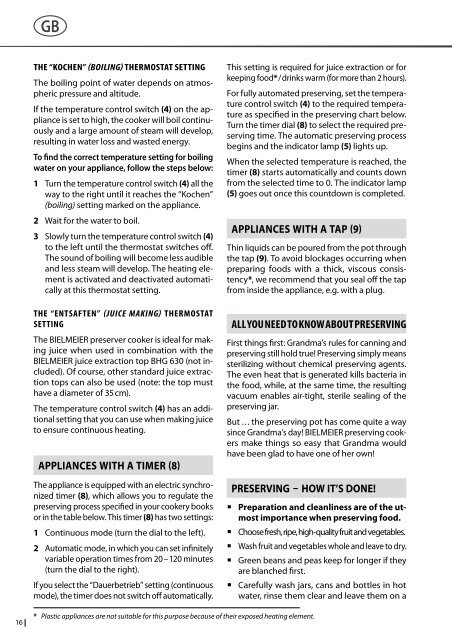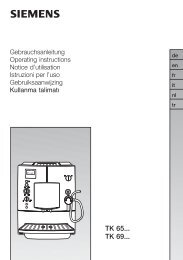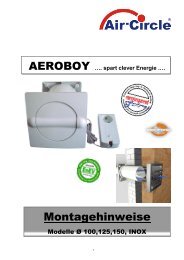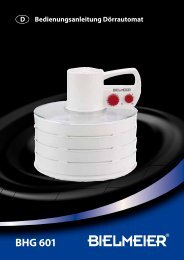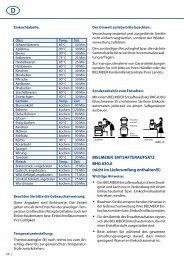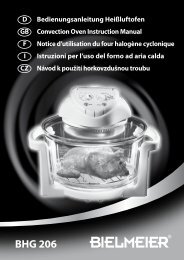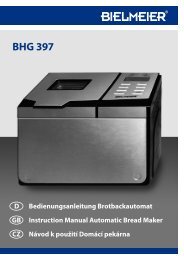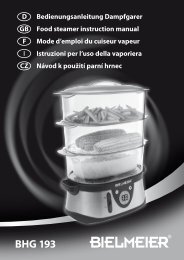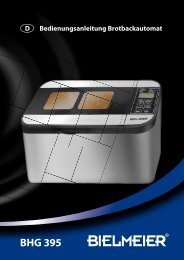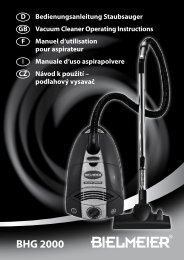F - Bielmeier
F - Bielmeier
F - Bielmeier
Create successful ePaper yourself
Turn your PDF publications into a flip-book with our unique Google optimized e-Paper software.
GB<br />
GB<br />
16<br />
The “Kochen” (boiling) thermostat setting<br />
The boiling point of water depends on atmospheric<br />
pressure and altitude.<br />
If the temperature control switch (4) on the appliance<br />
is set to high, the cooker will boil continuously<br />
and a large amount of steam will develop,<br />
resulting in water loss and wasted energy.<br />
To find the correct temperature setting for boiling<br />
water on your appliance, follow the steps below:<br />
1 Turn the temperature control switch (4) all the<br />
way to the right until it reaches the “Kochen”<br />
(boiling) setting marked on the appliance.<br />
2 Wait for the water to boil.<br />
3 Slowly turn the temperature control switch (4)<br />
to the left until the thermostat switches off.<br />
The sound of boiling will become less audible<br />
and less steam will develop. The heating element<br />
is activated and deactivated automatically<br />
at this thermostat setting.<br />
The “Entsaften” (juice making) thermostat<br />
setting<br />
The BIELMEIER preserver cooker is ideal for making<br />
juice when used in combination with the<br />
BIELMEIER juice extraction top BHG 630 (not included).<br />
Of course, other standard juice extraction<br />
tops can also be used (note: the top must<br />
have a diameter of 35 cm).<br />
The temperature control switch (4) has an additional<br />
setting that you can use when making juice<br />
to ensure continuous heating.<br />
Appliances with a timer (8)<br />
The appliance is equipped with an electric synchronized<br />
timer (8), which allows you to regulate the<br />
preserving process specified in your cookery books<br />
or in the table below. This timer (8) has two settings:<br />
1 Continuous mode (turn the dial to the left).<br />
2 Automatic mode, in which you can set infinitely<br />
variable operation times from 20 – 120 minutes<br />
(turn the dial to the right).<br />
If you select the “Dauerbetrieb” setting (continuous<br />
mode), the timer does not switch off automatically.<br />
This setting is required for juice extraction or for<br />
keeping food* / drinks warm (for more than 2 hours).<br />
For fully automated preserving, set the temperature<br />
control switch (4) to the required temperature<br />
as specified in the preserving chart below.<br />
Turn the timer dial (8) to select the required preserving<br />
time. The automatic preserving process<br />
begins and the indicator lamp (5) lights up.<br />
When the selected temperature is reached, the<br />
timer (8) starts automatically and counts down<br />
from the selected time to 0. The indicator lamp<br />
(5) goes out once this countdown is completed.<br />
Appliances with a tap (9)<br />
Thin liquids can be poured from the pot through<br />
the tap (9). To avoid blockages occurring when<br />
preparing foods with a thick, viscous consistency*,<br />
we recommend that you seal off the tap<br />
from inside the appliance, e.g. with a plug.<br />
All you need to know about preserving<br />
First things first: Grandma's rules for canning and<br />
preserving still hold true! Preserving simply means<br />
sterilizing without chemical preserving agents.<br />
The even heat that is generated kills bacteria in<br />
the food, while, at the same time, the resulting<br />
vacuum enables air-tight, sterile sealing of the<br />
preserving jar.<br />
But . . . the preserving pot has come quite a way<br />
since Grandma's day! BIELMEIER preserving cookers<br />
make things so easy that Grandma would<br />
have been glad to have one of her own!<br />
Preserving – how it’s done!<br />
* Plastic appliances are not suitable for this purpose because of their exposed heating element.<br />
• Preparation and cleanliness are of the utmost<br />
importance when preserving food.<br />
• Choose fresh, ripe, high-quality fruit and vegetables.<br />
• Wash fruit and vegetables whole and leave to dry.<br />
• Green beans and peas keep for longer if they<br />
are blanched first.<br />
• Carefully wash jars, cans and bottles in hot<br />
water, rinse them clear and leave them on a<br />
clean cloth to dry.<br />
• Check all containers for any stubborn residues<br />
and for damage.<br />
• Wash the seals in hot soapy water and then<br />
leave them in clean water until they are needed.<br />
• Do not use any porous, damaged or stretched<br />
rubber rings or rubber caps.<br />
• To fill the containers:<br />
– The containers should only ever be filled up<br />
to 2 cm at most below the mouth of the jar.<br />
– For foods with a mushy consistency (e. g.<br />
apple sauce), leave 3 – 4 cm headspace<br />
between the top of the preserve and the<br />
mouth of the jar.<br />
– For sausages of any kind, only fill the container<br />
¾ full.<br />
– For foods that will swell during the preserving<br />
process (e.g. cake mixture), only fill the<br />
container up to ½ full.<br />
– Please also note the instructions provided<br />
by the jar manufacturer.<br />
• Seal the containers tightly with screw-caps,<br />
fasteners or clamps.<br />
• Always place the jars on the grating insert (8)<br />
when putting them into the cooker. Different<br />
sized jars can be used.<br />
(Fig. 1)<br />
• Ensure that the glasses are 2⁄3 to ¾ submerged<br />
in the water. If you are using two levels of jars,<br />
this applies to the upper level.<br />
The optimal water fill levels:<br />
• The water temperature should be roughly the<br />
same as the temperature of the jars when you<br />
place them in the cooker. This saves both time<br />
and energy.<br />
• Place the lid on the pot.<br />
• Connect the appliance to the mains. Check<br />
your recipe or the preserving chart for the<br />
required preserving temperature and time<br />
and make the corresponding settings on your<br />
BIELMEIER preserving cooker.<br />
• The time taken for the cooker to heat up does<br />
not count as part of the preserving time. The<br />
preserving time does not start until the selected<br />
temperature is reached.<br />
• Unplug the appliance once the preserving process<br />
is complete.<br />
• Remove the jars. Leave the clamps on the jars<br />
until they have cooled down completely. At this<br />
point, place the jars immediately in cold water.<br />
• Your preserves are best stored in a cool, dry<br />
and dark place.<br />
• It is useful to label each container with the<br />
date and its contents.<br />
• Refer to your cookery books for information<br />
and ideas on preserving fruit, vegetables,<br />
meat, etc. For some ideas, why not check out<br />
our recipe section on page 18.<br />
Preserving chart<br />
Fruit Temp. Time<br />
Redcurrants 85°C 20 mins.<br />
Apples, pears 90° C 30 mins.<br />
Strawberries 75° C 25 mins.<br />
Blueberries 85° C 25 mins.<br />
Raspberries, gooseberries 80° C 30 mins.<br />
Cherries, yellow plums 80° C 30 mins.<br />
Peaches, apricots, damsons 90° C 30 mins.<br />
Rhubarb Boil 30 mins.<br />
Vegetables Temp. Time<br />
Cauliflower Boil 90 mins.<br />
Beans, peas Boil 120 mins.<br />
Broad beans Boil 90 mins.<br />
Gherkins 90° C 30 mins.<br />
Carrots, turnip cabbage Boil 90 mins.<br />
Pumpkin 90° C 30 mins.<br />
Brussels sprouts,<br />
Boil 120 mins.<br />
asparagus, savoy cabbage<br />
Tomatoes 90° C 30 mins.<br />
Meat Temp. Time<br />
Large meat cuts, precooked Boil 75 mins.<br />
Goulash, precooked Boil 75 mins.<br />
Game and poultry, precooked Boil 75 mins.<br />
Sausage meat Boil 120 mins.<br />
17


